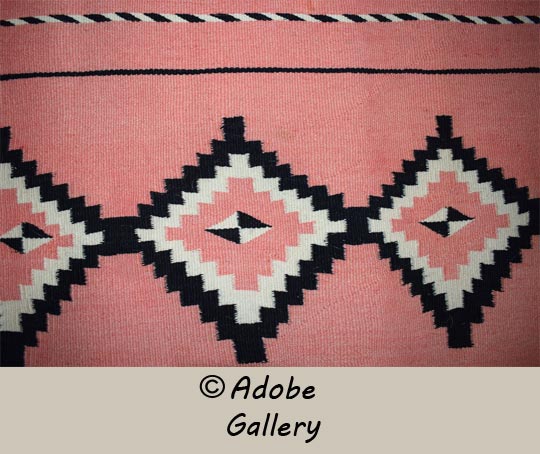Navajo Germantown Blanket, Sarape Style, 1890-1910
+ Add to my watchlist Forward to Friend
Forward to Friend
- Category: Navajo Textiles
- Origin: Diné of the Navajo Nation
- Medium: Germantown wool
- Size: 69 x 49 inches
- Item # C4824H
- Price: $12000
The Diné of the Navajo Nation weavers were introduced to commercial Germantown yarn during their incarceration at Bosque Redondo, New Mexico, beginning in 1863. Their turmoil did not end until they were allowed to return to their native lands in 1868. Before they were forcefully marched to Bosque Redondo, their traditional clothing consisted of blankets, sarapes, and two-piece wool dresses. Before their capture, the Diné owned over two hundred thousand sheep. When they were released to return to their home, they had less than 1000 sheep. The scarcity of sheep at Bosque Redondo was supplemented by the government with commercial wool from Germantown, Pennsylvania, to keep the Diné weavers occupied.
When the women returned home, they were not interested in processing wool from their sheep. Their concern was on survival, not on processing wool for weaving. They were used to commercial yarn and chose to continue using it. Thus, the name of textiles of that period became known as Germantown blankets.
This textile is of the style woven with commercial yarn following the return of the Diné to their homeland. The yarn was commercially spun to a consistent thickness and was easy to weave. This blanket was woven with a large amount of rosé wool for the main field, and black and white wool for the design pattern. The yarn selected by the weaver was deliberately chosen from different dye lots as that is what they were familiar with from their own wool from the past. The weavers were experimenting with optical designs during this period as seen in this blanket. The central stacked diamonds would fall down the wearer's spine, and the two outer bands would fall on the front of the wearer, providing a dramatic image.
The optical designs in Germantown blankets are quite fascinating. These designs often feature geometric patterns that create visual effects, making the blankets appear dynamic and vibrant. The weavers used shapes like diamonds, zigzags, and chevrons. These shapes were arranged in a way that could create a sense of movement or depth. Many designs were symmetrical and repeated across the blanket. This repetition can trick the eye into seeing patterns that seem to shift or move as you look at them. This sarape is absolutely beautiful in its understated use of color.
Condition: very good condition
Provenance: this Navajo Germantown Blanket, Sarape Style, 1890-1910 is from the estate of a client of Adobe Gallery
Recommended Reading: Kaufman, Alice and Christopher Selser. The Navajo Weaving Tradition 1650 to the Present
TAGS: textiles, Navajo Nation

- Category: Navajo Textiles
- Origin: Diné of the Navajo Nation
- Medium: Germantown wool
- Size: 69 x 49 inches
- Item # C4824H
- Price: $12000
Adobe Gallery Recommended Reading
Adobe Gallery Recommended Items
If you are interested in this item, we would also like to recommend these other related items:



